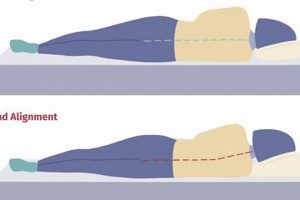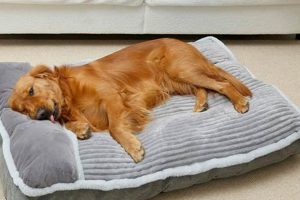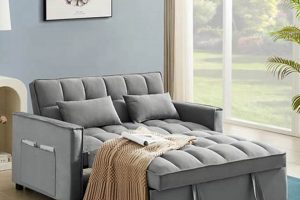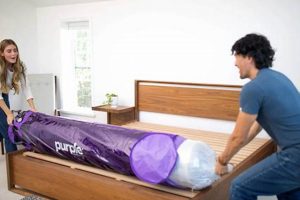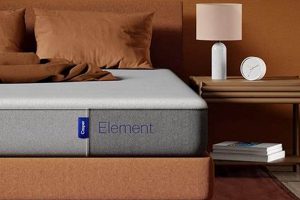A cushioning component designed to conform to the folding frame of convertible seating, it provides a sleeping surface when the sofa is deployed. These items are often thinner than standard bed alternatives, prioritizing flexibility for storage within the sofa mechanism. An example would be a memory foam insert sized to fit a queen-sized fold-out couch, designed to offer enhanced comfort over the original equipment.
The significance of a quality sleeping surface in convertible furniture lies in promoting restful sleep and enhancing the overall functionality of the sofa. Historically, these mattresses were often an afterthought in sofa design, resulting in discomfort for users. Modern advancements in materials and construction techniques have allowed for improved support, durability, and a more agreeable sleeping experience. This impacts both the perceived value of the sofa and its suitability for accommodating overnight guests, or for regular use as a sleeping space in smaller living areas.
The subsequent sections will examine different types of these components available, considerations for choosing the appropriate option, the factors influencing their longevity, and strategies for maintaining their quality over time.
Selecting a Sleeper Sofa Replacement Mattress
The following recommendations are designed to aid in making an informed decision regarding the acquisition of an appropriate sleeping surface for a convertible sofa.
Tip 1: Measure Accurately: Prior to purchase, verify the precise dimensions of the existing frame when fully extended. Inaccurate measurements may result in a mismatch, rendering the selected component unusable. Consult the sofa manufacturer’s documentation or measure the frame directly with a measuring tape, accounting for any recessed areas.
Tip 2: Consider Material Composition: Evaluate various materials, such as memory foam, innerspring, or latex, based on individual needs and preferences. Memory foam conforms to the body, potentially alleviating pressure points. Innerspring variants offer a more traditional feel. Latex possesses inherent resilience and breathability. Research the properties of each material to determine its suitability.
Tip 3: Assess Thickness and Density: Evaluate the thickness of the component based on comfort requirements and space constraints when the sofa is folded. Higher density indicates greater support and durability, though it may also affect the ease of folding the sofa. A balance between comfort and practicality is crucial.
Tip 4: Evaluate Support Structure: Examine the underlying support structure if present, especially in innerspring designs. The gauge and coil count can significantly impact the level of support provided. Higher gauge coils often offer a firmer feel, while a greater coil count generally enhances support distribution.
Tip 5: Prioritize Breathability: Consider airflow properties to mitigate heat retention during sleep. Materials with open-cell structures or integrated ventilation features can improve breathability and enhance comfort, particularly in warmer climates.
Tip 6: Check for Certifications: Verify that the selected product meets relevant safety and environmental standards. Certifications such as CertiPUR-US ensure that the foam has been tested for harmful chemicals and meets stringent standards for emissions and durability.
Tip 7: Inquire about Warranty and Return Policies: Clarify the terms of any warranty offered by the manufacturer or retailer. Understanding the warranty coverage and return policies is essential for addressing potential defects or dissatisfaction with the product.
By carefully considering these factors, the selection process can be streamlined, resulting in the acquisition of a fitting component that enhances the utility and comfort of the convertible sofa.
The following segments will provide guidance on ensuring long-term usage and maintenance.
1. Thickness
The thickness of a sleeping surface for convertible seating directly impacts user comfort. A thinner profile is often necessitated by the folding mechanism, but excessively reduced depth can compromise support and pressure relief. Conversely, a thicker unit, while potentially providing greater comfort, might impede the sofa’s ability to fold and close correctly, leading to mechanical stress on the frame and upholstery. The selection of an appropriate thickness requires a balance between these competing factors. For instance, an innerspring mattress exceeding four inches in thickness may create difficulties in folding the sleeper sofa, while a memory foam option of similar dimensions might offer adequate compressibility for proper closure. The original equipment specifications provide a crucial reference point, although advancements in material science now allow for increased comfort in thinner profiles.
Real-world examples illustrate the consequences of mismatched thickness. If a four-inch replacement is installed in a frame designed for a three-inch unit, the sofa might not close completely, exposing the mattress to dust and wear, while also potentially damaging the frame’s hinges. Conversely, a two-inch replacement in a frame designed for a four-inch unit may result in an uncomfortably firm and unsupportive sleeping surface. Understanding the precise tolerances of the specific sleeper sofa mechanism is paramount. Further considerations involve the user’s weight and sleeping preferences, as these influence the required level of support. Heavier individuals may necessitate a denser, thicker profile to prevent bottoming out, while those preferring a softer feel might opt for a thinner memory foam layer.
In conclusion, the thickness represents a critical dimension that determines both the comfort and functionality of the sleeping surface within a convertible sofa. It requires careful consideration of frame specifications, material properties, and individual user needs. Deviation from the optimal thickness can result in compromised comfort, impaired sofa functionality, or accelerated wear and tear. Selecting a replacement with precisely matched dimensions remains a key factor in ensuring a satisfactory and enduring sleeping arrangement.
2. Density
Density, in the context of a sleeper sofa replacement mattress, refers to the mass of the material per unit volume. This attribute directly influences the mattress’s support, durability, and overall comfort, making it a critical consideration during the selection process. Higher density typically translates to greater resistance to compression and a longer lifespan, while lower density options may offer a softer feel at the expense of longevity.
- Support and Spinal Alignment
A denser foam or coil structure provides more substantial support, contributing to proper spinal alignment during sleep. This is especially important for mitigating back pain and ensuring a restful night. For example, a sleeper sofa mattress with high-density memory foam will contour to the body, evenly distributing weight and reducing pressure points, whereas a low-density option may sag and offer insufficient support.
- Durability and Longevity
Higher density materials generally exhibit greater resistance to wear and tear. A high-density foam core will be less prone to sagging or developing impressions over time, thus extending the life of the mattress. Conversely, a low-density mattress may degrade rapidly with regular use, requiring more frequent replacement. The density rating is therefore a key indicator of the investment’s long-term value.
- Weight and Foldability
While higher density often correlates with improved support and durability, it also increases the overall weight of the mattress. This can impact the ease of folding and unfolding the sleeper sofa mechanism. A balance must be struck between density and weight to ensure that the mattress provides adequate support without compromising the sofa’s functionality. Lightweight, high-density foams represent an ideal, albeit often more expensive, solution.
- Heat Retention and Breathability
Denser materials can sometimes exhibit reduced breathability, potentially leading to increased heat retention during sleep. Open-cell foam structures and integrated ventilation features are often incorporated into high-density mattresses to mitigate this effect. It is essential to consider the breathability characteristics of a dense replacement mattress, particularly for individuals who tend to sleep hot.
The density of a sleeper sofa replacement mattress is a multifaceted characteristic that governs its support, durability, weight, and breathability. Careful consideration of these factors, in relation to individual needs and preferences, is crucial for selecting a replacement that provides both comfort and long-term value. Balancing density with other attributes, such as material composition and thickness, allows for the optimization of the sleeping experience within the constraints of a convertible sofa.
3. Material composition
The constituent materials of a sleeper sofa replacement mattress directly dictate its comfort, durability, and overall performance. Careful consideration of these materials is therefore paramount in selecting a suitable replacement, as different compositions offer distinct advantages and disadvantages.
- Foam Types (Memory, Polyurethane, Latex)
Memory foam conforms to the body’s contours, providing pressure relief and motion isolation, beneficial for couples. Polyurethane foam offers a more traditional, responsive feel and is often less expensive, though potentially less durable. Latex, derived from rubber trees, provides a balance of support and responsiveness with inherent breathability and resistance to allergens. The choice depends on individual preferences and specific needs, such as pressure point sensitivity or allergy concerns. For instance, individuals prioritizing motion isolation may prefer memory foam, while those seeking a cooler sleep surface might consider latex.
- Innerspring Coils (Type, Gauge, and Count)
Innerspring mattresses utilize coils for support, with variations including Bonnell, offset, and pocketed coils. The coil gauge (thickness) determines firmness, with lower gauges indicating a firmer feel. Coil count influences support distribution; a higher count generally offers more consistent support. The type of coil construction affects motion transfer; pocketed coils minimize motion transfer more effectively than interconnected coil systems. Consider the trade-offs between firmness, support, and motion isolation when selecting an innerspring replacement. For example, a higher gauge coil would be selected for firmer back support.
- Fiber Fill (Polyester, Cotton, Wool)
Fiber fill materials are often used in the quilting or comfort layers of a sleeper sofa replacement mattress, contributing to surface plushness and breathability. Polyester is a common, cost-effective option offering reasonable loft and resilience. Cotton provides good breathability and moisture absorption but may compress over time. Wool offers natural temperature regulation and moisture-wicking properties, enhancing comfort in various climates, though typically at a higher cost. The choice depends on budgetary constraints and desired comfort characteristics. Wool might be selected when superior temperature control is valued.
- Cover Fabrics (Cotton, Polyester Blends, Specialty Fabrics)
The cover fabric impacts breathability, durability, and surface feel. Cotton is a breathable and comfortable option, while polyester blends offer enhanced durability and stain resistance. Specialty fabrics may incorporate advanced features such as moisture-wicking or antimicrobial properties. Consider the balance between comfort, durability, and specific needs, such as allergy management, when selecting a cover fabric. A polyester blend might be preferred where increased durability is needed for frequent use.
These compositional elements interact to determine the overall performance profile of the replacement mattress. The correct material selection tailored to individual requirements ensures optimal comfort and extends the serviceable lifespan of the sleeper sofa. Failure to carefully consider these material properties can result in discomfort, premature wear, and a diminished sleeping experience.
4. Frame Compatibility
Frame compatibility is a critical determinant of the performance and longevity of any sleeper sofa replacement mattress. The physical dimensions, structural support, and mechanical constraints imposed by the sofa frame must be precisely aligned with the replacement mattress’s characteristics to ensure proper function and user comfort.
- Dimensional Accuracy
Precise measurements of the sleeper sofa frame, when fully extended, are essential. Length, width, and thickness must be meticulously recorded and matched to the corresponding dimensions of the replacement. An undersized mattress will provide inadequate support, while an oversized one may prevent the sofa from closing correctly or place undue stress on the folding mechanism. Incorrect dimensions lead to compromised sleep quality and potential damage to the sofa structure. For example, a queen-sized frame requiring a 60×72 inch mattress will not accommodate a standard queen mattress of 60×80 inches, necessitating a custom or specifically sized replacement.
- Support Structure Alignment
The underlying support system of the sofa frame, whether composed of metal grids, wooden slats, or a combination thereof, must provide adequate and uniform support to the replacement. Inadequate or uneven support can lead to mattress sagging, premature wear, and compromised spinal alignment for the user. The replacement mattress should be designed to distribute weight evenly across the frame’s support structure. For example, if the frame has widely spaced slats, a thicker, denser mattress may be required to prevent sagging between the supports.
- Folding Mechanism Clearance
The thickness and flexibility of the replacement must be compatible with the folding and unfolding action of the sofa mechanism. A mattress that is too thick or insufficiently pliable can impede the mechanism’s operation, leading to difficulty in converting the sofa or potential damage to the frame. The replacement should be selected with specific attention to the manufacturer’s recommendations regarding maximum mattress thickness and flexibility. If a tri-fold mechanism is present, the mattress must bend appropriately at the designated points without excessive resistance.
- Edge Support Integration
The design of the sofa frame’s edges dictates the required edge support characteristics of the replacement. Adequate edge support prevents the user from rolling off the mattress and contributes to a more uniform sleeping surface. The replacement should be selected to provide consistent support across its entire surface, including the edges. A mattress with reinforced edges is often necessary to compensate for frames that lack substantial perimeter support. This is especially important for sleeper sofas used by multiple occupants.
The integration of these facets ensures that the replacement functions optimally within the confines of the existing framework. Failure to properly account for these considerations can lead to a suboptimal sleeping experience, damage to the sofa mechanism, and a reduced lifespan for both the mattress and the frame itself.
5. Foldability
The capacity of a sleeper sofa replacement mattress to conform to the folding mechanism is paramount to the furniture’s functionality. The mattress must compress and articulate without excessive resistance to facilitate seamless conversion between sofa and bed configurations. The degree of foldability determines both the ease of use and the potential for long-term stress on the sofa’s frame and internal components.
- Material Compression and Resilience
The materials comprising the mattress core must exhibit adequate compression under pressure while retaining sufficient resilience to return to their original shape after deployment. Materials such as memory foam and certain types of polyurethane foam are often selected for their ability to compress readily. However, insufficient resilience can lead to permanent deformation, reducing the mattress’s overall support and comfort over time. An example of inadequate compression would be an innerspring mattress that resists folding, impeding the sofa’s closure and potentially damaging the frame. Conversely, a mattress lacking resilience might develop permanent indentations in areas subject to frequent folding.
- Hinge Point Flexibility
Sleeper sofas utilize hinges to enable the folding action. The replacement mattress must exhibit flexibility at these points to prevent bunching or excessive stress on the hinges. Segmentation of the mattress core or the use of flexible materials at hinge locations are common strategies to enhance foldability. For instance, a tri-fold sofa requires the mattress to bend at two distinct hinge points; reinforcement of these areas can prevent premature wear and tear. A lack of flexibility at these hinge points can cause the mattress to buckle or tear, compromising its structural integrity and making the sofa difficult to operate.
- Thickness Considerations
The thickness of the replacement mattress has a direct bearing on its foldability. Thicker mattresses inherently offer greater comfort but also present a greater challenge to the folding mechanism. Exceeding the sofa frame’s specified maximum thickness can lead to significant resistance during folding, potentially damaging the frame and impeding the sofa’s conversion. Careful adherence to the manufacturer’s recommendations regarding mattress thickness is therefore essential. A thicker mattress might require greater force to fold, potentially shortening the lifespan of the folding mechanism. Conversely, an excessively thin mattress may fold easily but lack adequate support for comfortable sleep.
- Cover Fabric Elasticity
The elasticity of the mattress cover fabric plays a role in facilitating foldability. A cover fabric that lacks sufficient stretch can restrict the mattress’s ability to compress and conform to the folding mechanism. Elastic or knit fabrics are frequently employed to enhance flexibility and prevent tearing during folding. The cover should be durable enough to withstand the repeated stresses of folding and unfolding. A non-elastic cover could rip or tear along the folding lines, reducing the mattress’s aesthetic appeal and potentially exposing the underlying materials to damage.
These elements of foldability directly influence the operational lifespan and comfort of the sleeper sofa. A replacement mattress selected without careful consideration of these factors can compromise the furniture’s core functionality, leading to operational difficulties and reduced user satisfaction. Selecting a replacement that balances comfort with the necessary degree of foldability is crucial for optimizing the sofa’s overall utility.
6. Support quality
Support quality, in relation to a sleeper sofa replacement mattress, directly influences the sleeper’s spinal alignment and overall comfort. The degree to which a replacement mitigates pressure points and maintains a neutral spinal posture directly impacts the quality of sleep. A mattress offering insufficient support can cause back pain, discomfort, and restless sleep. Conversely, a well-supported mattress distributes weight evenly, reducing pressure and promoting relaxation. The selection of an appropriate firmness level and support structure is thus paramount. An example illustrates this point: an individual with chronic back pain selecting a low-density foam replacement might experience exacerbated pain due to inadequate spinal support, whereas a higher-density memory foam or innerspring variant could provide significant relief.
The correlation extends to the long-term health of the sleeper. Poor support can contribute to or worsen existing musculoskeletal issues. Mattresses lacking appropriate support often exhibit sagging, leading to uneven weight distribution and spinal misalignment. This, in turn, can result in chronic pain and discomfort. To mitigate these risks, one should analyze the underlying support system of the original equipment, considering factors such as coil count (if applicable), foam density, and overall construction. High-density foam or pocketed coil systems often represent preferable alternatives for maximizing support. Furthermore, the intended use case influences this decision; a sofa bed used infrequently may not necessitate the same level of support as one employed nightly.
In conclusion, the support quality of a sleeper sofa replacement mattress is a critical factor in determining its suitability. Selecting a replacement that prioritizes proper spinal alignment and pressure relief is essential for ensuring a comfortable and healthful sleep experience. Challenges arise in balancing support with foldability and overall mattress thickness, but prioritizing support within these constraints leads to a superior and more valuable product.
7. Breathability
Breathability, in the context of a sleeper sofa replacement mattress, refers to the capacity of the mattress materials to facilitate airflow and dissipate heat. This characteristic is crucial for maintaining a comfortable sleeping temperature and minimizing moisture accumulation, thereby contributing to a more restful sleep experience.
- Material Composition and Airflow
The constituent materials of the replacement mattress significantly impact its breathability. Open-cell foam structures, such as those found in certain memory foam and latex formulations, allow for greater airflow compared to closed-cell structures. Natural fibers like cotton and wool incorporated into the mattress cover or comfort layers can also enhance breathability and moisture-wicking properties. Conversely, synthetic materials with low porosity may restrict airflow, leading to increased heat retention and discomfort. For example, a replacement mattress constructed with high-density, closed-cell memory foam covered in a synthetic fabric may trap heat, causing the sleeper to feel uncomfortably warm. In contrast, a latex mattress with an open-cell structure and a cotton cover will promote airflow, helping to regulate temperature.
- Heat Dissipation and Temperature Regulation
Effective breathability enables the mattress to dissipate body heat efficiently, preventing overheating and promoting a stable sleeping temperature. The accumulation of heat can disrupt sleep cycles and contribute to discomfort. Replacement mattresses designed with enhanced breathability features, such as ventilation channels or phase-change materials, actively regulate temperature by absorbing and releasing heat as needed. A mattress lacking breathability may cause the sleeper to sweat excessively, leading to disrupted sleep and potential skin irritation. Conversely, a breathable mattress will help to maintain a comfortable microclimate, reducing the likelihood of overheating and promoting restful sleep.
- Moisture Management and Hygiene
Breathability also plays a vital role in managing moisture within the mattress. By allowing for air circulation, moisture from sweat and humidity can evaporate more readily, preventing the growth of mold, mildew, and bacteria. Replacement mattresses with poor breathability can become breeding grounds for allergens and pathogens, potentially leading to respiratory problems and skin irritations. A breathable mattress promotes a drier, more hygienic sleeping environment, reducing the risk of these issues. For example, a mattress used in a humid climate benefits significantly from enhanced breathability to minimize moisture accumulation.
- Design Features and Ventilation
Certain design features can enhance the breathability of a replacement mattress. Ventilation channels, perforations, or convoluted foam surfaces can create pathways for airflow within the mattress core. The incorporation of breathable fabrics, such as mesh panels or knit constructions, in the mattress cover also promotes air circulation. These design elements work in concert to facilitate heat dissipation and moisture management, resulting in a more comfortable and hygienic sleep surface. A mattress lacking such features may suffer from poor breathability, even if the constituent materials are inherently breathable. Thus, the overall design of the replacement is essential.
In conclusion, breathability is a critical performance attribute of a sleeper sofa replacement mattress. The material composition, design features, and ventilation capabilities of the replacement mattress collectively determine its ability to regulate temperature, manage moisture, and promote a comfortable sleeping environment. Prioritizing breathability is essential for ensuring a restful and healthful sleep experience, particularly for individuals prone to overheating or living in humid climates. The interplay of these factors influences the long-term comfort and usability of the sleeper sofa as a sleeping surface.
Frequently Asked Questions
This section addresses common inquiries regarding the selection, usage, and maintenance of replacement mattresses for sleeper sofas. The information provided aims to clarify key aspects and assist in making informed decisions.
Question 1: What factors determine the compatibility of a replacement with an existing sleeper sofa frame?
Dimensional accuracy, including length, width, and thickness, is paramount. The replacement must conform to the fully extended frame dimensions and allow for proper folding without exceeding the mechanism’s tolerance. Ensure the support structure of the frame aligns with the mattress’s requirements to prevent sagging.
Question 2: How does the density of a mattress impact its suitability as a replacement?
Density correlates with support and durability. Higher density materials offer greater resistance to compression and promote proper spinal alignment. However, excessive density can increase weight and hinder foldability. A balance between support and ease of operation is essential.
Question 3: What are the implications of material composition on comfort and longevity?
Material choice dictates surface feel, breathability, and durability. Memory foam offers pressure relief, while innerspring systems provide traditional support. Natural materials such as latex and wool offer enhanced breathability. Selection should reflect individual preferences and usage patterns.
Question 4: How can breathability be assessed and optimized in a replacement selection?
Breathability is determined by material porosity and design features. Open-cell foam structures and natural fiber covers promote airflow and reduce heat retention. Ventilation channels and moisture-wicking fabrics further enhance breathability, contributing to a more comfortable sleep environment.
Question 5: What role does foldability play in the functionality of the replacement?
The mattress must readily compress and articulate at hinge points to facilitate the folding action. Excessive resistance can damage the sofa’s mechanism and impede conversion. The chosen replacement should adhere to the manufacturer’s thickness recommendations and exhibit sufficient flexibility.
Question 6: What maintenance practices extend the lifespan of a sleeper sofa replacement mattress?
Regular rotation minimizes uneven wear. The use of a mattress protector safeguards against spills and stains. Periodic vacuuming removes dust and allergens. Adherence to these practices preserves the integrity of the materials and prolongs the mattress’s usability.
The answers provided offer guidance for making informed decisions concerning replacement options. Proper consideration of these factors contributes to enhanced sleep quality and the extended utility of the sleeper sofa.
The subsequent section will delve into potential issues and troubleshooting techniques relevant to these components.
Sleeper Sofa Replacement Mattress
This article has explored the multifaceted considerations inherent in selecting a suitable cushioning component for convertible seating. Factors such as dimensional accuracy, material density, compositional elements, frame compatibility, foldability, support quality, and breathability profoundly influence the product’s utility and longevity. The information presented equips individuals to navigate the complexities of replacement, optimizing comfort and maximizing the value of their convertible furniture.
Therefore, informed decision-making is paramount. The long-term benefits of a judicious selection extend beyond immediate comfort, contributing to improved sleep quality and the prolonged functionality of the sleeper sofa. Careful assessment of the factors outlined herein represents a critical investment in both personal well-being and furniture preservation.


